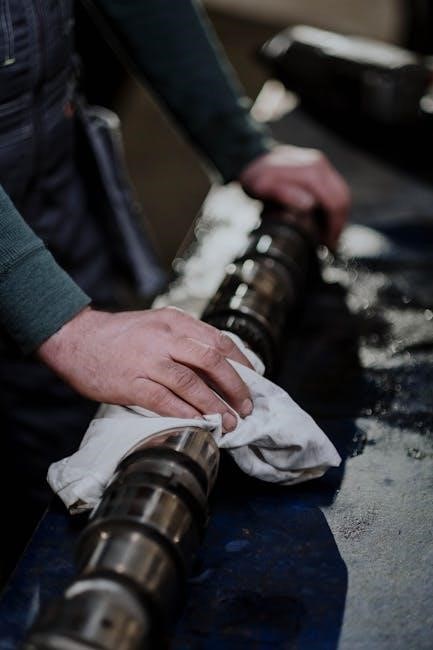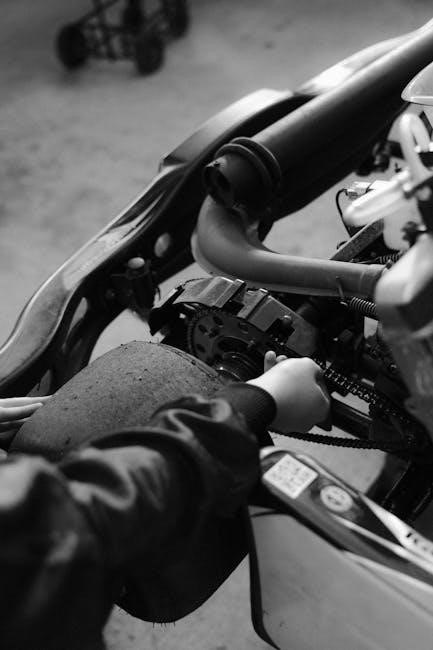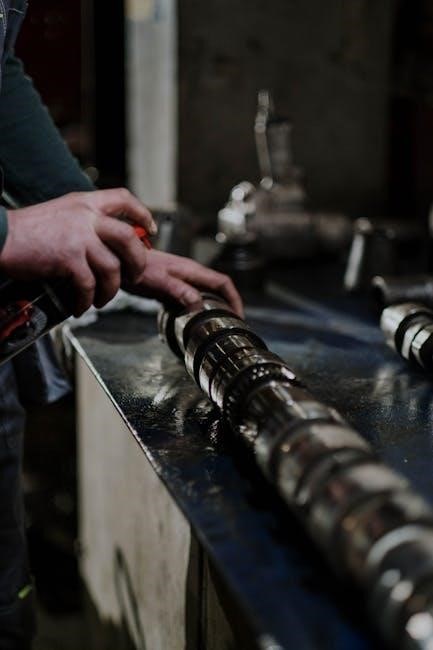Upgrading from an automatic to a manual licence offers greater driving flexibility and improved skills․ It requires practice and passing a driving test in a manual vehicle․
Overview of the Process
Upgrading from an automatic to a manual licence involves several key steps․ First, applicants must obtain an unrestricted learner permit for manual vehicles․ Next, they typically enroll in a certified driving school or practice with an experienced driver to master clutch control and gear shifting․ Once comfortable, they book and pass a driving test in a manual car, demonstrating proficiency in handling the vehicle․ Finally, upon passing, they apply for a full manual driving licence․ This process ensures drivers transition smoothly from automatic to manual, enhancing their driving skills and flexibility; Regular practice and patience are essential for success․
Importance of Upgrading to a Manual Licence
Upgrading to a manual licence offers several advantages․ It provides increased driving flexibility, allowing operation of both manual and automatic vehicles․ Manual driving enhances control and connection with the car, improving overall driving skills․ Many countries require a manual licence for certain vehicle categories, making it essential for professional or specific driving needs․ Additionally, manual vehicles are often more cost-effective in terms of purchase and maintenance․ Upgrading ensures compliance with licensing laws and avoids penalties for driving a manual car with an automatic licence․ It also opens opportunities for driving a wider range of vehicles, both domestically and internationally․

Understanding the Legal Requirements
To upgrade from an automatic to a manual licence, you must meet specific legal criteria, including holding a current automatic licence and completing required training hours․
Differences Between Automatic and Manual Licences
Holding an automatic licence restricts you to driving only automatic vehicles, while a manual licence allows operation of both manual and automatic cars․ To obtain a manual licence, you must pass a driving test in a manual car, demonstrating proficiency in clutch and gear shifting․ Eligibility typically requires holding a valid automatic licence and, in some regions, completing a certified training program․ Regional variations exist, such as Ireland requiring an Unrestricted Learner Permit, while Dubai has specific RTA processes․ Understanding these distinctions is crucial for making an informed decision about upgrading your licence․
Eligibility Criteria for Upgrading
To upgrade from an automatic to a manual licence, you must hold a valid automatic driving licence and meet specific requirements․ In many regions, applicants must obtain an Unrestricted Learner Permit, such as Category B in Ireland․ Additionally, enrolling in a certified driving school and completing a minimum number of training hours may be mandatory․ Some areas, like Dubai, require applicants to apply through the RTA and undergo specific evaluations․ Ensure you meet all local eligibility criteria before initiating the upgrade process to avoid delays or complications․

Step-by-Step Guide to Upgrading
Apply for an Unrestricted Learner Permit, enroll in a certified driving school, practice driving a manual car, and pass the driving test to upgrade your licence․
Step 1: Apply for an Unrestricted Learner Permit
To begin upgrading your licence, you must first apply for an Unrestricted Learner Permit․ Visit your local transport authority’s website or office to initiate the process․ Complete the application form, providing required documentation such as proof of identity and residency․ Pay the applicable fees and submit your application․ Once approved, you will receive your permit, allowing you to legally practice driving a manual vehicle under supervision․ Ensure you meet the eligibility criteria, such as age requirements and holding a valid automatic licence․ This step is essential before proceeding to further stages of the upgrade process․
Step 2: Enroll in a Certified Driving School
Enrolling in a certified driving school is a crucial step in mastering manual driving․ These schools offer structured lessons tailored to your needs, focusing on clutch control, gear shifting, and smooth acceleration․ Instructors provide personalized feedback, helping you build confidence and skill․ Many schools offer specific programs for transitioning from automatic to manual licences․ Use the official map of certified driving schools to select a reputable option near you․ Ensure the school is accredited to guarantee quality instruction․ Regular attendance and active participation in lessons will accelerate your progress and prepare you for the driving test․ This step is vital for a smooth transition to manual driving․
Step 3: Practice Driving a Manual Car
Practicing in a manual car is essential to master clutch control and smooth gear shifts․ Start in a safe, open area like an empty parking lot to avoid traffic stress․ Focus on coordinating the clutch pedal with accelerator pressure to prevent stalling․ Gradually progress to quieter roads to practice shifting gears at varying speeds․ Pay attention to uphill and downhill driving to improve control․ Regular practice helps build muscle memory and confidence․ Use the time to refine your technique and address common mistakes, such as riding the clutch or grinding gears․ Consistent practice ensures readiness for the driving test and real-world scenarios․
Step 4: Book and Pass the Driving Test
Contact your local driving authority to book a driving test in a manual car․ Ensure you arrive early with your learner permit and car insurance․ During the test, the examiner will assess your ability to control the vehicle, focusing on smooth gear shifting, clutch operation, and overall driving proficiency․ Passing the test demonstrates your competence in handling a manual car, allowing you to apply for a full manual driving licence․ If you fail, you may need to wait before retaking the test․ Preparation and practice are key to success․
Step 5: Apply for a Full Manual Driving Licence
After passing your driving test, submit an application for a full manual driving licence․ Complete the required form, provide proof of identity, and include your test results․ Pay the applicable fees and wait for processing․ Once approved, your new licence will replace your learner permit, granting you full privileges to drive manual vehicles․ Ensure all documents are accurate to avoid delays․ This final step completes your transition from an automatic to a manual licence, enhancing your driving capabilities and flexibility on the road․
Practical Tips for Learning Manual
Start on flat ground, use the clutch smoothly, and practice shifting gears gradually․ Stall frequently to build muscle memory and confidence in controlling the vehicle․
Mastering the Clutch and Gear Shifting
Mastering the clutch and gear shifting is essential for transitioning from an automatic to a manual licence․ Begin by practicing in a safe, flat area, slowly pressing the clutch while shifting gears․ Focus on feeling the “biting point” of the clutch to avoid jerky starts․ Shift gears smoothly, matching your speed to the appropriate gear․ Avoid “riding the clutch,” as this can wear out the clutch system․ Practice accelerating gradually and downshifting before stopping․ Regular practice in varying conditions will build confidence and improve your ability to control the vehicle effortlessly․ Consistency is key to becoming proficient in manual driving․
Practicing in a Safe Environment
When upgrading from an automatic to a manual licence, practicing in a safe environment is crucial․ Start in an empty parking lot or quiet street with minimal traffic․ Ensure the area is flat and free from obstacles to avoid distractions․ Have a licensed driver accompany you for guidance and safety․ Begin with basic maneuvers like starting, stopping, and shifting gears smoothly․ Gradually progress to more complex scenarios, such as inclines or turning, as your confidence grows․ Avoid high-traffic areas until you feel comfortable controlling the vehicle․ Regular practice in a calm, stress-free setting will help you master manual driving effectively․
Common Mistakes to Avoid
When transitioning from an automatic to a manual licence, common mistakes include riding the clutch, which can cause wear and tear on the clutch system․ Over-revving the engine while shifting gears is another frequent error, leading to poor fuel efficiency and potential engine damage․ Forgetting to depress the clutch fully before shifting can result in rough gear changes or even damage to the transmission․ Additionally, stalling the car frequently due to improper clutch and accelerator coordination is common․ Avoiding these mistakes requires patience, consistent practice, and a focus on smooth, deliberate movements while driving․

Regional Variations in Licence Upgrading
Licence upgrading processes vary globally․ In the U․S․, states may require additional tests, while Ireland demands an Unrestricted Learner Permit and a manual driving test․ Dubai simplifies the process for automatic licence holders to switch to manual vehicles through the RTA․
Process in the United States
In the U․S․, upgrading from an automatic to a manual licence typically requires applying for an unrestricted learner permit and completing a driving test in a manual vehicle․ Some states may require additional documentation or fees․ Practice with a certified instructor or experienced driver is recommended to master clutch control and gear shifting․ Once proficient, schedule and pass a manual driving test at your local DMV․ Note that state-specific requirements may vary, so check with your local Department of Motor Vehicles for detailed instructions․ Successful completion allows drivers to operate both automatic and manual vehicles legally․
Process in Ireland
In Ireland, upgrading from an automatic to a manual licence involves obtaining an Unrestricted Learner Permit (Category B) and passing a driving test in a manual vehicle․ Applicants must first apply for the learner permit, which requires completing the necessary paperwork and paying the associated fees․ Once the permit is issued, practice driving a manual car is essential, often under the supervision of a certified driving instructor․ After gaining sufficient experience, individuals can book and pass the driving test․ Upon successful completion, they can apply for a full manual driving licence, granting legal permission to drive both automatic and manual vehicles․
Process in Dubai
In Dubai, holders of automatic licences can upgrade to a manual licence by applying through the Roads and Transport Authority (RTA)․ The process begins with submitting the required documents, including a valid automatic licence and completed application forms․ Applicants must then enroll in a certified driving school for a 7-hour training program designed to transition from automatic to manual driving․ After completing the training, individuals can take the RTA driving test in a manual vehicle․ Passing the test allows them to obtain a manual driving licence, enabling legal operation of both manual and automatic cars in Dubai․

Benefits of Holding a Manual Licence
Holding a manual licence offers increased flexibility, improved driving skills, and cost-effectiveness, as manual vehicles are often more affordable to purchase and maintain than automatics․
Increased Driving Flexibility
Holding a manual licence allows you to drive both manual and automatic vehicles, offering greater flexibility in transportation choices․ This enables you to rent cars, borrow vehicles, or drive different types of cars without restrictions․ Whether traveling or sharing a car with friends, a manual licence eliminates the need to worry about the transmission type․ This versatility is particularly beneficial in regions where manual cars are more common or preferred․ By upgrading, you gain the freedom to operate any vehicle, enhancing your independence and adaptability on the road․ This flexibility is a key advantage of obtaining a manual driving licence․
Improved Driving Skills
Upgrading to a manual licence enhances your driving abilities by requiring active engagement with the vehicle․ Mastering the clutch and gear shifting improves control and situational awareness․ Drivers develop better coordination and reflexes, leading to smoother and more precise maneuvers․ This skill set is particularly advantageous in challenging conditions, such as uphill driving or towing․ Additionally, the ability to manage manual transmission fosters a deeper connection with the car, making you a more attentive and capable driver overall․ The process of learning manual driving sharpens your multitasking skills and reaction times, ultimately elevating your proficiency behind the wheel and boosting confidence in various driving scenarios․
Cost-Effectiveness of Manual Vehicles
Manual vehicles are often more affordable to purchase and maintain than their automatic counterparts․ Lower production costs and simpler mechanical systems reduce initial purchase prices․ Additionally, manual cars typically have better fuel efficiency, leading to long-term savings on petrol․ Maintenance and repair costs are also generally lower, as manual transmissions have fewer complex components․ These financial advantages make upgrading to a manual licence a practical choice for drivers seeking cost-effective transportation․ Furthermore, the resale value of manual cars can be higher in certain markets, providing added economic benefits for owners․ Overall, manual vehicles offer a budget-friendly option for drivers․

Challenges of Switching to Manual
Switching to manual involves mastering the clutch and gear shifting, requiring significant practice․ Physical demands and steep learning curves can make the transition difficult for some drivers initially․
Steep Learning Curve
Switching from an automatic to a manual licence presents a steep learning curve, as mastering the clutch and gear shifting requires coordination and practice․ Many drivers struggle with synchronizing the clutch pedal and accelerator, leading to stalling or jerky movements․ The physical demands of constant gear changes and the mental effort to anticipate shifting points can be overwhelming initially․ Additionally, the need to manage multiple controls simultaneously can be daunting for those accustomed to automatic transmissions․ However, with consistent practice and patience, most learners adapt and become proficient in operating a manual vehicle effectively․
Physical Demands of Manual Driving
Manual driving requires significant physical effort, particularly in heavy traffic or hilly terrain․ Operating the clutch pedal and gearshift demands consistent leg and hand coordination․ Frequent use of the clutch and accelerator can lead to fatigue, especially during long drives․ Drivers with physical limitations may find manual driving challenging․ The constant need to press the clutch and shift gears can strain the left leg and hand, making automatic vehicles a more accessible option for some․ This physical demand is a key consideration when deciding to switch from an automatic to a manual licence․
Time Commitment for Practice
Mastering a manual licence demands a significant time commitment for practice․ Learners must dedicate hours to refining clutch control, smooth gear shifts, and coordination․ Regular practice sessions are essential to build muscle memory and confidence․ Even those with automatic licences will need to allocate consistent time to adapt to manual driving․ The process requires patience, as progress may be gradual․ Without sufficient practice, learners may struggle during the driving test․ It’s crucial to balance practice with rest to avoid fatigue and maintain focus․ Time invested in mastering manual driving skills will ultimately lead to success in obtaining the licence․

Legal Implications of Driving Without a Manual Licence
Driving a manual car with an automatic licence carries legal penalties, including fines and potential licence suspension․ Compliance with licensing laws is essential to avoid legal consequences․
Penalties for Driving a Manual Car with an Automatic Licence
Driving a manual vehicle with an automatic licence can result in legal penalties, including fines and potential licence suspension․ Authorities enforce strict compliance with licensing laws, ensuring only qualified drivers operate manual transmissions․ Failure to adhere to these regulations may lead to legal consequences, highlighting the importance of upgrading your licence․ Always verify local laws and consider the risks of non-compliance․ If unsure, consult your local transport authority or legal advisor for guidance on licence requirements and penalties․ This ensures safe and lawful driving practices for all road users․
Importance of Compliance with Licensing Laws
Compliance with licensing laws is crucial for maintaining legal driving privileges and ensuring road safety․ Operating a vehicle without the appropriate licence category can lead to severe penalties, including fines and licence suspension․ Licensing laws are designed to verify a driver’s ability to safely operate specific types of vehicles․ By adhering to these regulations, drivers demonstrate their commitment to road safety and legal standards․ Non-compliance not only risks personal consequences but also jeopardizes the safety of other road users․ Always ensure your licence matches the type of vehicle you intend to drive to avoid legal complications and contribute to a safer driving environment․

Maintenance and Care for Manual Vehicles
Regular maintenance ensures optimal performance of manual vehicles․ Check clutch systems, monitor transmission fluid levels, and replace components as needed to prevent wear and extend lifespan․
Understanding the Clutch System
The clutch system is a critical component in manual vehicles, enabling smooth transitions between gears․ It consists of a clutch pedal, master cylinder, and slave cylinder, working together to disengage and engage the engine from the transmission․ Proper clutch control is essential for seamless gear shifting, preventing wear on the clutch plate and surrounding components․ Over time, excessive wear can lead to reduced performance and increased repair costs․ Regular inspection and maintenance of the clutch system ensure optimal functionality and extend the lifespan of your manual vehicle․
Regular Maintenance Tips
Regular maintenance is crucial for extending the lifespan of your manual vehicle․ Check the clutch fluid level regularly and ensure the brake pads are in good condition․ Monitor the transmission oil level, as low levels can cause gear shifting issues․ Inspect the clutch pedal for proper alignment and responsiveness․ Listen for unusual noises during gear shifts, as they may indicate wear on components․ Schedule periodic servicing with a certified mechanic to maintain optimal performance and prevent costly repairs․ Consistent upkeep ensures smooth operation and extends the durability of your manual car․
Extending the Lifespan of Your Manual Car
To extend the lifespan of your manual car, focus on proper clutch and gear care․ Avoid riding the clutch, as this can cause excessive wear on the clutch system․ Ensure smooth gear shifting by using the clutch fully and coordinating it with accelerator input․ Regularly check transmission oil levels and top them up if necessary․ Inspect the drivetrain and belts periodically for signs of wear․ Avoid aggressive driving, as rapid acceleration and harsh braking can strain the manual components․ Lastly, schedule professional inspections to address potential issues early and maintain your car’s performance over time․
Upgrading to a manual licence enhances driving skills and flexibility․ With dedication and practice, drivers can master manual transmission, gaining confidence and long-term benefits on the road․
Final Thoughts on Upgrading Your Licence
Upgrading from an automatic to a manual licence is a rewarding process that enhances driving skills and flexibility․ While it requires practice and dedication, the ability to master manual transmission is highly beneficial․ Drivers gain better control over their vehicle and open up opportunities to drive a wider range of cars․ Overcoming the initial challenges of learning to operate a manual car builds confidence and improves overall driving proficiency․ Persistence is key, as the long-term advantages of holding a manual licence far outweigh the temporary difficulties of the learning curve․
Encouragement for Aspiring Manual Drivers
Embracing the challenge of learning to drive a manual car is a commendable step toward becoming a more versatile and skilled driver․ While the process may seem daunting, the rewards are well worth the effort․ Mastering a manual transmission enhances your driving abilities and opens doors to a broader range of vehicles․ Stay persistent, as practice and patience will lead to success․ Remember, thousands have made this transition, and with dedication, you can join their ranks․ The sense of accomplishment and improved control over your car make the journey truly worthwhile․